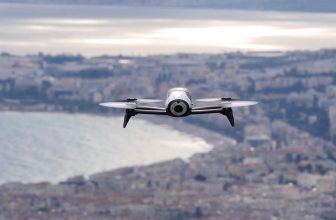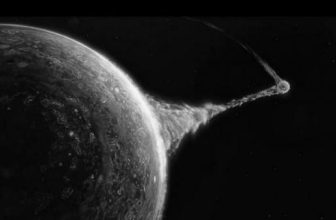
The Phantom 4 is DJI’s unmanned aerial vehicle (UAV) drone, and it is part of the Phantom series.
The white color body of the Phantom 4 Model gives it an appearance that is very comparable to that of earlier Phantom models, which are immediately apparent at first sight.
It certainly seem like the Phantom 4 has a rounder body than its predecessors, but this might just be an illusion. This may be revealing that there was a need to create extra room within the drone owing to the computer processor that was required for the model’s inclusion of five cameras and sensors.
Onboard processor
The latest variant of the Phantom 4, which has five cameras, is equipped with a computer processor so that it can manage the calculations caused by those cameras.
On board there are a total of 5 cameras, with 2 cameras facing ahead, 2 facing downward, and 1 being the primary camera.
By creating a three-dimensional representation of the object that the pilot orders the computer processor to concentrate on, the onboard processor is essentially making decisions without the pilot’s involvement. It is also the beginning stages of computer vision; using the optical sensors, the processor is able to construct the three-dimensional picture as well as analyze an image. Additionally, it uses machine learning and a computer processor to make judgments while the aircraft is in flight.
Processor for obstacle avoidance
The most recent iteration, the Phantom 4, has optical sensors for guiding as well, allowing it to steer clear of unintended accidents.
When the drone’s sensors identify the presence of an obstacle in its route, the device will evaluate the situation, make a judgment, and come to a halt in order to prevent a collision. Even if the operator is pushing the drone to go ahead at full speed, the processor will prevent it from colliding with anything in its path. When an obstacle is spotted by the drone’s sensors, the drone will make the choice to stop moving forward. The flight route may be altered in a number of ways, including going over and continuing on with the journey or stopping to wait for more instructions from the pilot. It is estimated that 15 meters will serve as both the sensor zone and the stopping distance during a flight in front of an object.
So what is different about the Phantom 4?
The following is a list of information to know:
- Tracking performed via computer vision. A three-dimensional representation of the topic is crafted by the computer’s CPU.
- It is able to keep up with a bicycle and trace its movements in any direction. In addition to this, it does not need any technological equipment in order to circle the topic. Using just the information provided by the computer vision, it follows the topic.
- More sensor cameras: The three-dimensional picture is constructed using the primary front-facing camera, in addition to two optical sensors that face ahead and two optical sensors that face downward.
- increased flight duration by 28 minutes total time spent in the air
- High-speed racing may be done in the Sport mode, which allows for maximum speeds of up to 72 kilometers per hour (45 miles).
- The topic is followed by the computer in a mode guided by computer vision.
- The Phantom with the least amount of difficulty to fly at this point: DJI’s drone that is the least difficult to pilot thus far.
- New attachment for the propeller: The propellers just pop in and twist to attach themselves; there are no screws involved.
- Onboard processor; computer optical sensor processor that is capable of constructing pictures in three dimensions.
- A pause button on the transmitter: Pressing the pause button on the transmitter will cause the drone to enter hover mode and remain there until the pilot provides further instructions or the drone is programmed to automatically return to its home base.
Additionally important is cutting-edge, innovative high technology. accompanied with a relatively affordable price tag. I really hope that life treats you well and that you have a healthy budget with sufficient finances for fun times and recreational demands for inventive and creative tools and toys.
The DJI Phantom vision has been unwrapped to display a number of design improvements as well as extra capabilities that allow better connection between the pilot and this computerized flying machine. The significant advance was made possible by using a software program developed by DJI to link a smart phone to an intelligent flying machine. It gives the pilot a greater degree of control over the camera that is on board as well as the flying vehicle itself. The following is a list of some of the best features:
- Using a Wi-Fi wireless connection to your mobile device, you are able to monitor real-time flight data in addition to a live camera view from a distance of up to 300 meters.
- Enhanced battery capacity and highest possible performance A Lithium Polymer battery with a capacity of 5200 mAh offers a flight duration of up to 25 minutes.
- The operating frequency of the Range Extender (2412-2462MHz). In an open environment, the communication distance is 300 meters. Transmitter Power <=17dBm. 1.5 watts of power are being used.
- The camera that comes with the set has a resolution of 14 megapixels and is compatible with both the RAW and JPEG file formats. Support for multiple captures, continuous capture, and timed capture is included in the camera. Additionally, the capacity for video streaming has been expanded, and HD recording at 1080/p30 or 1080/60i may now be accomplished.
- synchronization of the album. It is not necessary to connect the camera to a personal computer in order to synchronize the contents of the SD card with the picture album on your phone since you may do it immediately over Wi-Fi.
The elements that have been mentioned represent the most noticeable alterations to the new design. In order for you to be able to see the trip from the air, you will be required to give your own smartphone.
Both the iOS and Android operating systems can run the software apps for the DJI Phantom vision. Here are some suggestions. DJI Vision application system need for Mobile Device:
- iOS version 6.0 or above, or Android system version 4.0 or higher is required. The iPhone 4s, the iPhone 5, the iPhone 5s, and the iPod Touch 4 and 5 come highly recommended.
- iPad 3, iPad 4, and iPad mini are all options, but we do not suggest any of them.
- Samsung Galaxy S3, S4, Note 2, Note 3, or phones with a configuration very close to those models.
The previous model of the DJI Phantom did not include a camera, however, the DJI Vision model kit does. This is another way in which the DJI Vision model kit differs from the prior kit. There is the obvious problem that was brought up in the testing of the earlier models, as well as the better quality of the video streaming that was achieved by using the bespoke Zenmuse camera stabilizer. The software program that combines a smart phone with the smart flying machine is an evident major step forward, but there is also the inescapable problem of determining how smooth the video quality is with the stock basic DJI Phantom Vision package. The model that came before the Vision may be purchased for less than US$500.00 at this time. That brings the price of the DJI drone kit with the Zenmuse stabilizer and the GoPro camera up to around the same level as the Phantom Vision package that was released in 2013. The issue that still has to be answered is, then, how does the quality compare with the two different configurations?
- Go-Pro black series camera.
- The camera is a DJI Phantom Vision 14 MB.
- Mount for DJI cameras that are standard.
- Zenmuse custom built Go-Pro camera stabilizer
The DJI Phantom quad-copter weighs 1160 grams and is an entry level unmanned aerial vehicle (UAV). The camera should ideally be lightweight, and the Go-Pro camera, which weighs around 72 grams, meets this ideal. Adding a DSLR camera to the DJI Phantom Vision would be the equivalent of putting a person in danger by connecting a cord with a cannon ball to one of their legs. As a result, mounting an SLR camera to the Phantom Vision would not increase the image quality in any way. When it comes to the choice of camera for the DJI Phantom Vision, professionally speaking, there are not many alternatives available. So what are your options?
- Go-Pro camera.
- DJI Phantom Vision 14 Megapixel camera.
However, the most important thing to keep in mind is that we are discussing the beginning stages of aerial photography. There is a lot of creative options that become available as a result of the extra third-dimensional vision of shooting. Therefore, the capacity to think creatively, to produce fresh and engaging visuals and video, and to think outside of the box are the most important skills to have. Forget the mindset that you need the greatest camera to be able to capture the finest images, since that is not true. All you need is a good eye and some practice. Even if you have the most greatest camera equipment, it is quite unlikely that the photographs you take will be as good as one would expect them to be unless you have a solid understanding of photography and the kinds of settings that provide the best results. Therefore, the best strategy may consist of being creative, being adaptable in order to make the most of what one already possesses, building upon what one already knows, and continuing to learn how to make the videos and images create a more favorable impression of the natural environment that we take pleasure in. I hope that watching this video of the DJI Phantom vision unwrapped preview has inspired you to think of new ways to be creative in the future, regardless of whether the activities you have planned are purely for recreational purposes or are intended to produce high-quality videos and photographs for use in a business setting.
Artificial intelligence And Computer Vision
Concepts such as artificial intelligence, computer vision, and machine learning are some examples of technologies that make it possible for machines to function on their own.
Computer vision and artificial intelligence cover a lot of ground together, including issues such as learning methods and pattern recognition. Because of this, some people consider computer vision to be a subfield of artificial intelligence, while others consider it to be a subfield of computer science in general.
“Image processing, image analysis, and machine vision are the areas of study that are most directly connected to the discipline of computer vision. There is a considerable amount of duplication in the spectrum of methods and applications that are covered by these. This suggests that the fundamental approaches that are used and developed in various areas are, for the most part, equivalent to one another, which is something that might be read as suggesting that there is just one field with multiple titles. On the other hand, it seems to be necessary for research groups, scientific journals, conferences, and companies to present or market themselves as belonging specifically to one of these fields, and as a result, a variety of characterizations that distinguish each of the fields from the others have been presented.






